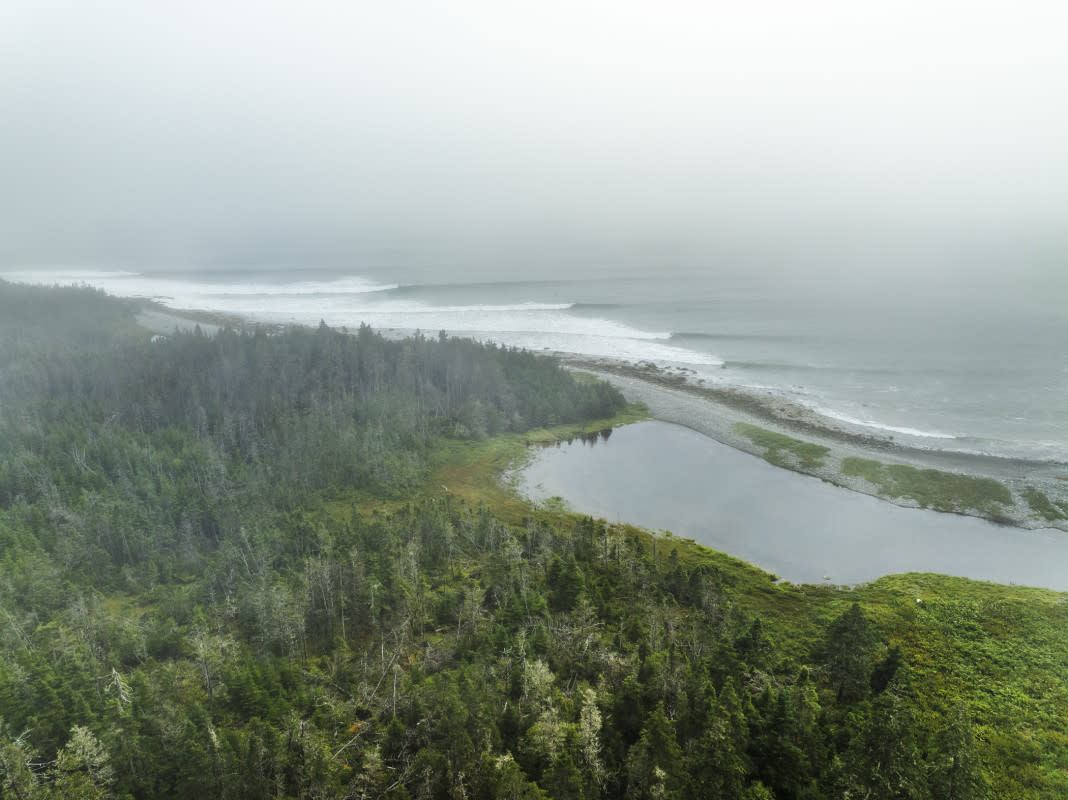North Bound on the Eastern Flank (Photos)

Brian Nevins
“Gas is on me. I think we can find simple, cheap accommodation. Camera Batteries are charged. No pros, no hype and a really bad Spotify playlist.”
That was a text from New Hampshire ace lensman Brian Nevins to Joe Carter and Mikey Evans as Hurricane Ernesto grazed the Caribbean and started a more northerly track, due to send groundswell to the entire East Coast.
The replies came back within minutes.
“Let’s go. I’m in for the long drive. Waves would be a bonus.”
“Are you bringing camping gear?”
“It’s an F-150, so we can stack a lot of boards.”
“We can find cheap, simple accommodations.”
“Beautiful scenery. Questionable weather.”
They were off into the wilds of New England. And they scored.
“The only thing we were sure of was the endless road ahead,” said Carter, who understands that what looks like a few inches on a map could be hours of switchback driving from a town or highway out to a remote point.
But the key phrase was, “No pros. No hype.”

Brian Nevins
Nevins and Carter are veterans of surfing media. They were both crucial in documenting what was happening on the East Coast for a few decades.
In that time period, it was just a given that if you had to have professional surfers with you to make photos or video of a surf trip publishable.
Quick refresher: The surf industry used to invest heavily in teams and team rider visibility. They would pay to advertise products with images of their surfers, which mean the industry had considerable sway over the surf media. There may have been a good story to tell about travel or culture. but if you didn’t have a pro out there surfing, there was no brand to buy your photos/videos, no sponsor to help with travel costs and no media would run your work. Hence, everything revolved around the brand and the surfer.
But today, Nevins and Carter are no longer tied to that business model to feed their families (to be honest, that model barely exists anymore.) But at one time they were vitally important to the voice of Northeast surfing. Nevins, New Hammy born and bred, held a very unique position as both staff photog for Surfer and Snowboarder. While he traveled the world documenting culture, travel and waves, his photos had a way of humanizing experiences. His editorial resume and commercial client list is among the most impressive of all the photogs who transitioned after the social media sea change.

Brian Nevins
Carter, now living in Maine, was a pioneer in New England surf cinema. A road warrior into his 30s, he was among the first to professionally document that extremely core and unique surf scene. He too transitioned to work that balanced commercial with documentary work, capturing scenes after natural disasters for Duracell and later Kowasaki, Wrangler and the Discovery Channel. Today, he works alongside Maine lobstermen, on multi-day trips in often treacherous conditions, telling the story of their lives and grueling work. Together, with Maine photog, Nick LaVecchia, they had one of the most impressive art/media collectives to serve any regional subculture with the website GetintheVan.com. They told the stories they wanted to tell, untethered from surf industry dollars.
And after the years of hard work at rebuilding careers while starting families in New England, they took advantage of a summer hurricane to check some spots far off the surf maps that Nevins had been curious about for years.
“We went pushing as far as we could to explore new surf spots. The only thing we were sure of was the endless road ahead,” Carter said, “It had been a while since Brian and I had hung out, so the drive itself was therapeutic—plenty of time to catch up on life and solve the world’s problems.”
Nevins navigated them to his X on the map and then saw something move in the early mist.
“They couldn’t even see what I was looking at. When they did, they kind of wrote it off. I walked down closer and could see something definitely peeling,” remembers Nevins.
I wasn’t a critical wave, but they no longer needed that to compete for page space or digital eyeballs.
“I just put on my wetsuit. I wasn’t even going to give anyone a chance to alter the plan. When I got out, there were head high waves. They surfed farther up and got it really good. I had that peeling section to myself the whole time,” he gushed
They have no way of knowing what hearty woodfolk or fishermen have surfed there, but they found it empty. They were not big on details and we weren’t busybodies in pushing for them.
“Eventually, we found a remote left-hand point break where the waves filled in just right, offering up some playful, fun surf,” added Nevins, “We surfed until we couldn’t anymore, and I’m still riding the high from that trip.”

Brian Nevins

Brian Nevins

Brian Nevins

Brian Nevins

Brian Nevins
Related: Hurricane Ernesto Brings A-Plus Summertime Surf To East Coast
